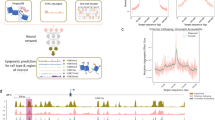Summary
Using a sigmoid relationship between gene dosage and phenotype, a computer model is presented that accurately simulates the effects of epistasis for quantitative traits in three experimental designs; the basic generations (i.e. parents, F1’s, F2’s and backcrosses), inbred families produced by single seed descent, and the triple test cross. It is shown that the classical expectations for components of generation means and variances are fulfilled when the genetical control is additive or interactive. Furthermore departures from the classical situation found in practice were also exhibited by our model. It seems likely, therefore, that in future studies, this inherently more flexible model for predicting the effect of epistasis may replace other methods of simulating epistasis.
Similar content being viewed by others
Article PDF
References
Cavalli, L L. 1952. An analysis of linkage in quantitative inheritance. In Reeve, E. C. R. and Waddington, C. H. (eds.) Quantitative Inheritance, H.M.S.O., London, pp. 135–144.
Comstock, R E, and Robinson, H F. 1952. Estimation of average dominance of genes. In Gowen, J. W. (ed.) Heterosis, Iowa State College Press, Ames, Iowa, pp. 494–516.
Jinks, J L. 1979. The biometrical approach to quantitative variation. In Thompson, J. N. and Thoday, J. M. Quantitative Genetic Variation, Academic Press, London, 81–109.
Jinks, J L, and Jones, R M. 1958. Estimation of the components of heterosis. Genetics, 43, 223–234.
Jinks, J L, and Perkins, J M. 1969. The detection of linked epistatic genes for a metrical trait. Heredity, 24, 465–475.
Jinks, J L, and Perkins, J M. 1970. A general method for the detection of additive, dominance and epistatic components of variation: III. F2 and backcross populations. Heredity, 25, 419–429.
Jinks, J L, Perkins, J M, and Pooni, H S. 1973. The incidence of epistasis in normal and extreme environments. Heredity, 31 (2), 263–269.
Jinks, J L, and Pooni, H S. 1976. Predicting the properties of recombinant inbred lines derived by single seed descent. Heredity, 36, 253–266.
Kearsey, M J, and Jinks, J L. 1968. A general method of detecting additive, dominance and epistatic variation for metrical traits. I. Theory. Heredity, 23, 403–409.
Mather, K M, and Jinks, J L. 1982. Biometrical Genetics, 2nd Edn, Chapman and Hall.
Pooni, H S. 1976. Exploitation of Inbreds in Nicotiana rustica. Ph.D. Thesis, Department of Genetics, University of Birmingham.
Pooni, H S, and Jinks, J L. 1976. The efficiency and optimal size of triple test cross designs for detecting epistatic variation. Heredity, 36, 215–227.
Pooni, H S, and Jinks, J L. 1979. Sources and biases of the predictors of the properties of recombinant inbreds produced by single seed descent. Heredity, 42, 41–48.
Pooni, H S, and Jinks, J L. 1981. The true nature of non-allelic interaction in Nicotiana rustica revealed by association crosses. Heredity, 47, 253–258.
Pooni, H S, Jinks, J L, and Cornish, M A. 1977. The causes and consequences of non-normality in predicting properties of recombinant inbred lines. Heredity, 38, 329–338.
Sturley, S L. 1982. The consequences of epistasis in predicting the properties of recombinant inbred lines derived by single seed descent, as revealed by a computer simulation. M.Sc. Thesis, Department of Genetics, University of Birmingham.
Author information
Authors and Affiliations
Rights and permissions
About this article
Cite this article
Kearsey, M., Sturley, S. A model for the incorporation of epistasis into a computer simulation for three experimental designs. Heredity 52, 373–382 (1984). https://doi.org/10.1038/hdy.1984.45
Received:
Issue date:
DOI: https://doi.org/10.1038/hdy.1984.45
This article is cited by
-
The impact of recombination on short-term selection gain in plant breeding experiments
Theoretical and Applied Genetics (2013)
-
Selfing for the design of genomic selection experiments in biparental plant populations
Theoretical and Applied Genetics (2013)



